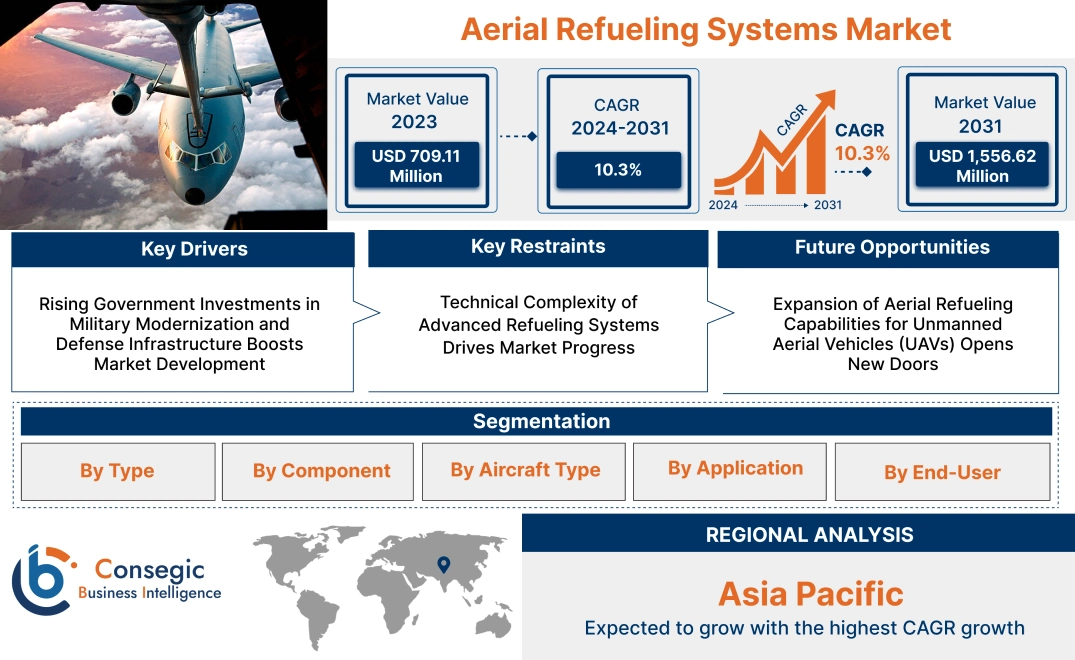- Summary
- Table Of Content
- Methodology
Aerial Refueling Systems Market Size:
Aerial Refueling Systems Market size is estimated to reach over USD 1,556.62 Million by 2031 from a value of USD 709.11 Million in 2023 and is projected to grow by USD 769.71 Million in 2024, growing at a CAGR of 10.3% from 2024 to 2031.
Aerial Refueling Systems Market Scope & Overview:
Aerial refueling systems are specialized equipment designed to transfer fuel from one aircraft to another during flight, extending the operational range and endurance of receiving aircraft. These systems are critical in military operations, enabling fighter jets, surveillance aircraft, and transport planes to remain airborne for longer durations without returning to base for refueling. The two primary methods of aerial refueling include the probe-and-drogue system and the boom-and-receptacle system, each tailored to specific aircraft requirements and mission profiles. These systems are utilized in defense aviation, where maintaining operational efficiency and extended mission capabilities is crucial. Modern refueling systems integrate advanced technologies such as automated fuel transfer and real-time monitoring to ensure safety and precision during refueling operations. Additionally, these systems are built to operate under extreme conditions, offering reliability and durability in high-stress environments. End-users of aerial refueling systems include air forces, defense organizations, and aircraft manufacturers. These stakeholders depend on these systems to enhance mission capabilities, support long-range operations, and ensure strategic flexibility in defense and military applications.
Aerial Refueling Systems Market Dynamics - (DRO) :
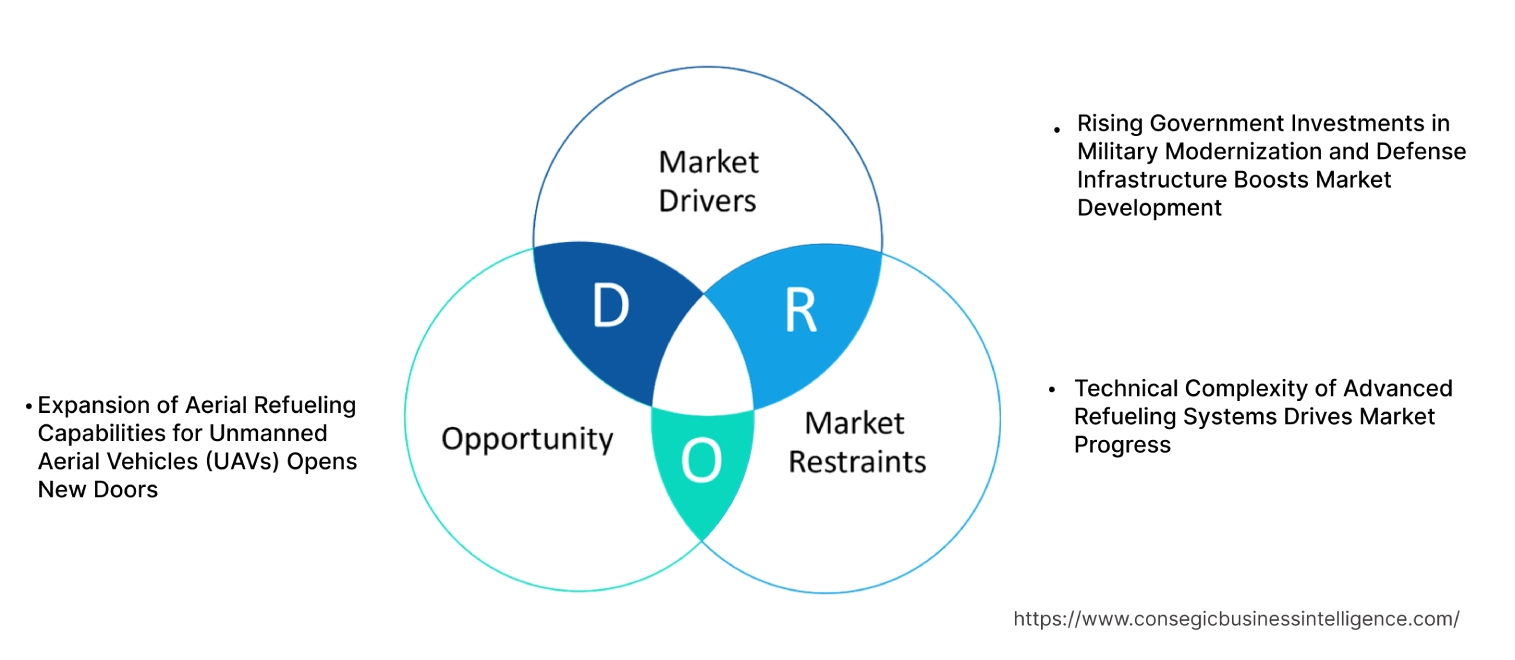
Key Drivers:
Rising Government Investments in Military Modernization and Defense Infrastructure Boosts Market Development
Many nations are prioritizing the enhancement of their air force capabilities by investing in advanced aircraft and support systems to address evolving security threats and geopolitical tensions. Aerial refueling systems, which extend the operational range and endurance of military aircraft, are a critical component of these modernization initiatives. Governments are also funding the development of next-generation technologies, such as autonomous refueling platforms and multi-role tanker aircraft, to enhance mission flexibility and operational readiness. For instance, increased defense budgets in regions like North America, Europe, and Asia-Pacific are enabling large-scale procurement of advanced refueling systems. This trend is particularly evident in nations aiming to strengthen their power projection capabilities and interoperability in joint military operations, driving demand for cutting-edge refueling technologies. Therefore, the increasing allocation of government funds for military modernization and defense advancements is boosting aerial refueling systems market demand, driven by the need for extended operational range and cutting-edge refueling technologies.
Key Restraints :
Technical Complexity of Advanced Refueling Systems Drives Market Progress
Advanced technologies like autonomous boom systems and UAV-based refueling platforms require specialized expertise in avionics, robotics, and AI, increasing development complexity and costs. Compatibility with legacy aircraft necessitates extensive modifications to airframes and fuel systems, raising financial and operational burdens. Rigorous testing under diverse conditions, such as high-altitude and adverse weather, adds to the complexity, while potential malfunctions in automated systems pose mission safety risks. Extensive training for pilots, boom operators, and maintenance crews is essential, demanding time and resources that may strain smaller military organizations. Advanced systems also rely on precise software algorithms and secure communication links, increasing the risk of failures during critical missions. These technical challenges, coupled with high costs and infrastructure demands, pose obstacles to aerial refueling systems market growth, especially in nations with limited resources or outdated defense equipment.
Future Opportunities :
Expansion of Aerial Refueling Capabilities for Unmanned Aerial Vehicles (UAVs) Opens New Doors
As UAVs take on increasingly complex and long-duration missions, the need for mid-air refueling to extend their operational range has become critical. Refueling-enabled UAVs support a wide range of applications, including intelligence, surveillance, and reconnaissance (ISR), as well as combat operations. The development of compact, lightweight refueling systems tailored for UAVs is creating new opportunities for manufacturers to meet the specific needs of this growing segment. Additionally, the use of UAVs as tanker drones to refuel other UAVs or manned aircraft further enhances their strategic value. This trend aligns with the broader shift toward integrating unmanned systems into modern military operations, creating substantial aerial refueling systems market opportunities and driving innovation and investment in advanced refueling technologies.
Aerial Refueling Systems Market Segmental Analysis :
By Type:
Based on type, the Market is segmented into Probe and Drogue, Boom and Receptacle, Flying Boom, and Autonomous Systems.
The Probe and Drogue segment accounted for the largest revenue of the total aerial refueling systems market share in 2023.
- The Probe and Drogue system is known for its operational flexibility, allowing multiple aircraft to refuel simultaneously in a single mission, making it highly efficient for large-scale military operations
- This technology is extensively utilized by NATO air forces due to its compatibility with both fixed-wing and rotary-wing aircraft, reducing logistical complexities.
- Modern upgrades, such as advanced stability mechanisms and real-time monitoring systems, are enhancing the reliability and precision of Probe and Drogue systems.
- The affordability of this system compared to other refueling methods makes it an attractive choice for developing nations investing in aerial refueling capabilities.
- As per aerial refueling systems market trends, the growing need for mid-air refueling to support longer missions in conflict zones reinforces the dominance of the Probe and Drogue segment.
The Autonomous Systems segment is projected to grow at the fastest CAGR during the forecast period.
- Autonomous refueling systems are pivotal for the future of aerial refueling, particularly with the increasing deployment of unmanned aerial vehicles (UAVs) in high-risk operations.
- These systems leverage advanced sensors, artificial intelligence, and machine learning algorithms to execute precise refueling maneuvers without human intervention.
- Governments in the United States, China, and Europe are funding R&D projects to integrate autonomous systems into next-generation refueling aircraft, aiming to enhance operational efficiency and reduce human error.
- The rising emphasis on reducing operational risks and improving mission success rates is driving investments in autonomous systems.
- Autonomous refueling systems are expected to play a critical role in supporting drone swarms and other futuristic defense strategies, contributing significantly to the aerial refueling systems market expansion by driving demand for innovative, scalable refueling solutions that enhance the operational capabilities of unmanned aircraft.
By Component:
Based on components, the market is segmented into Refueling Pods, Refueling Probes, Fuel Tanks, Hoses, Pumps, and Valves.
The Refueling Pods segment accounted for the largest market share in 2023.
- Refueling pods are equipped with state-of-the-art mechanisms, such as retractable hoses and drogue stabilization systems, ensuring efficient fuel transfer under challenging flight conditions.
- These pods are increasingly integrated with advanced telemetry systems, enabling real-time data transmission to improve operational decision-making.
- The modular design of modern refueling pods allows for easy retrofitting on a variety of aircraft, enhancing fleet versatility for defense forces.
- The increasing procurement of multi-role tanker aircraft equipped with advanced refueling pods by nations like the US and India is driving this segment's progress.
- As per aerial refueling systems market analysis, the dominance of refueling pods is underpinned by their essential role in enabling flexible, efficient, and reliable mid-air refueling operations.
The Data Management Systems segment is expected to register the fastest CAGR during the forecast period.
- Data management systems are becoming integral to aerial refueling, providing advanced analytics, mission planning, and post-mission debriefing functionalities.
- Data management systems are becoming integral to aerial refueling, providing advanced analytics, mission planning, and post-mission debriefing functionalities.
- The integration of cloud-based platforms with data management systems is enabling real-time data sharing across operational teams, enhancing mission efficiency.
- The segment's growth is supported by the increasing adoption of digital technologies in modernizing defense operations, driving the aerial refueling systems market growth.
By Aircraft Type:
Based on aircraft type, the market is segmented into Fixed-Wing, Rotary-Wing, and Unmanned Aerial Vehicles (UAVs).
The Fixed-Wing segment dominated the market with a share of 53.48% in 2023.
- Fixed-wing aircraft, such as fighter jets, bombers, and surveillance planes, heavily rely on aerial refueling systems to extend their operational range and mission duration.
- These aircraft are central to military strategies, requiring refueling capabilities to operate in remote areas or contested airspaces.
- Leading defense manufacturers are incorporating advanced refueling capabilities into modern fixed-wing aircraft to improve mission success rates.
- The dominance of the fixed-wing segment in the market reflects the critical role of these aircraft in global defense operations, from reconnaissance to strategic bombing, which is driving the aerial refueling systems market expansion.
The UAV segment is expected to register the fastest CAGR during the forecast period.
- The proliferation of UAVs in military and commercial applications, such as surveillance, logistics, and disaster management, is driving the need for aerial refueling systems tailored for drones.
- Autonomous aerial refueling for UAVs is enabling extended mission durations, particularly for high-altitude long-endurance (HALE) drones used in military operations.
- The rapid progress of this segment is fueled by technological advancements in lightweight, compact refueling systems designed specifically for UAVs.
- As per aerial refueling systems market analysis, governments and private operators are increasingly investing in UAV refueling capabilities to enhance operational flexibility and reduce mission costs.
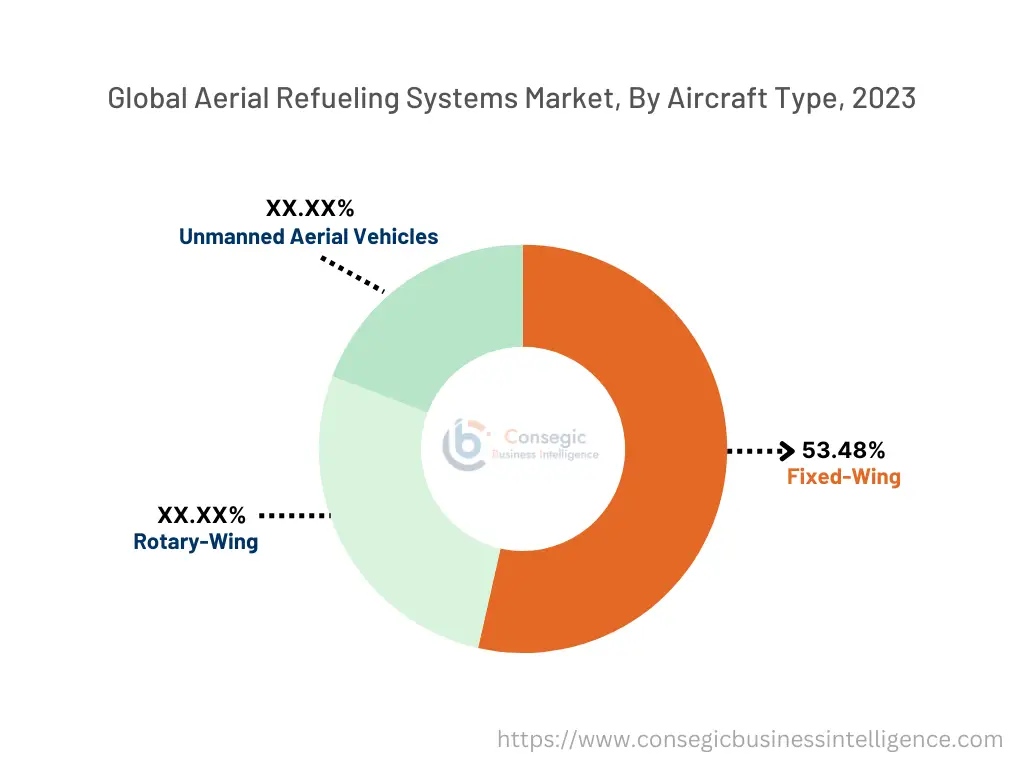
By Application:
Based on application, the market is segmented into Military Aviation, Commercial Aviation, and UAV Operations.
The Military Aviation segment accounted for the largest revenue of the total aerial refueling systems market share in 2023.
- Military aviation relies on refueling systems to maintain air superiority, conduct extended combat operations, and support humanitarian missions in remote regions
- Increasing geopolitical tensions and the rise in cross-border conflicts are driving significant investments in aerial refueling technologies by defense forces worldwide.
- Modern aerial refueling systems are equipped with stealth capabilities, enabling refueling operations in contested airspaces without detection.
- The dominance of the military aviation segment is due to the sector's reliance on mid-air refueling to achieve strategic and tactical objectives, which further fuels the aerial refueling systems market demand.
The UAV Operations segment is expected to register the fastest CAGR during the forecast period.
- The adoption of aerial refueling systems for UAV operations is transforming military and commercial aviation, enabling drones to perform long-endurance missions.
- Key applications include border surveillance, disaster relief, and supply chain logistics in remote areas, where traditional refueling options are unavailable.
- The development of autonomous refueling capabilities for drones is a major growth driver for this segment.
- As per aerial refueling systems market trends, the rapid extension of UAV operations across industries is expected to create substantial growth opportunities for aerial refueling system providers.
By End-User:
Based on end-users, the market is segmented into Defense Forces, Commercial Airlines, and UAV Operators.
The Defense Forces segment held the largest market share in 2023.
- Defense forces are the primary users of aerial refueling systems, leveraging them to support fighter jets, bombers, and surveillance aircraft in long-range missions.
- Investments in modernizing air fleets and incorporating next-generation refueling technologies are driving progress in this segment.
- Leading nations, including the US, China, and India, are prioritizing the procurement of advanced refueling systems to enhance their military capabilities.
- As per segmental trends analysis, the dominance of defense forces in the market reflects their need for reliable, robust, and efficient refueling systems to maintain strategic readiness.
The UAV Operators segment is expected to register the fastest CAGR during the forecast period.
- UAV operators are increasingly adopting refueling systems to extend the operational range of drones used in surveillance, logistics, and disaster response.
- The integration of aerial refueling capabilities with advanced UAV platforms is enabling cost-effective solutions for long-duration missions.
- The growth of the UAV operators segment is supported by the increasing need for drones in diverse applications, from military reconnaissance to commercial deliveries further encouraging aerial refueling systems market opportunities.
Regional Analysis:
The regions covered are North America, Europe, Asia Pacific, the Middle East and Africa, and Latin America.
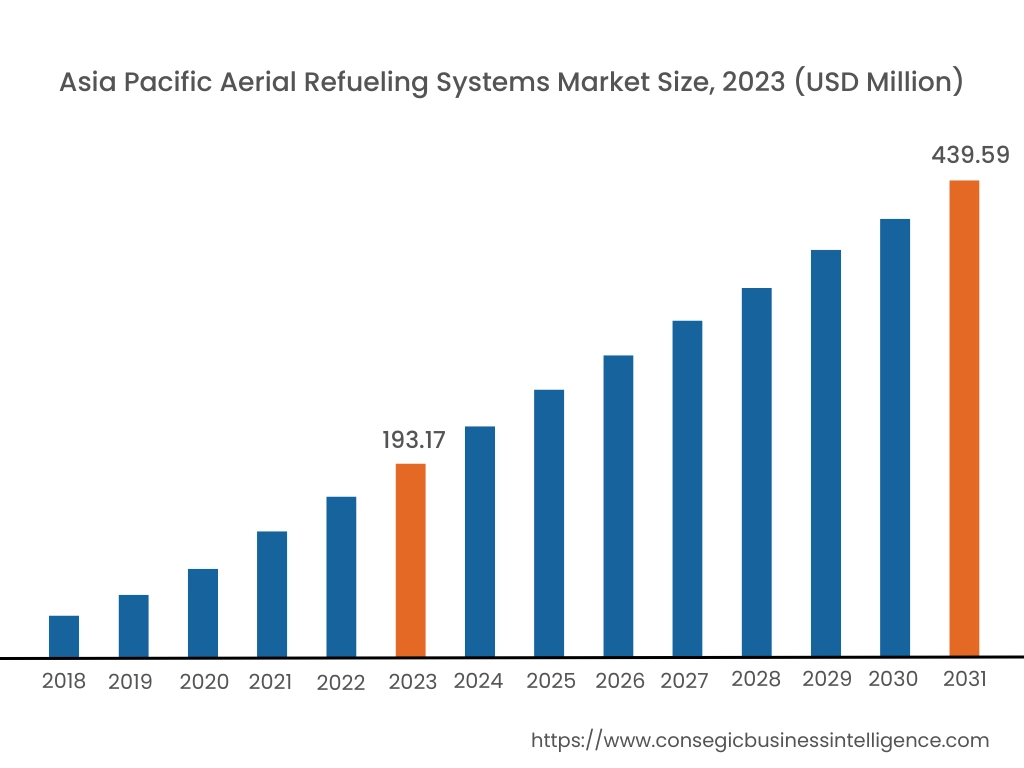
Asia Pacific region was valued at USD 193.17 Million in 2023. Moreover, it is projected to grow by USD 210.32 Million in 2024 and reach over USD 439.59 Million by 2031. Out of these, China accounted for the largest share of 28.3% in 2023. sThe region has become a global hub for defense procurement, with a strong emphasis on enhancing Air Force capabilities and operational readiness. The growing demand for multi-role aircraft and the integration of advanced refueling technologies contribute to market development.
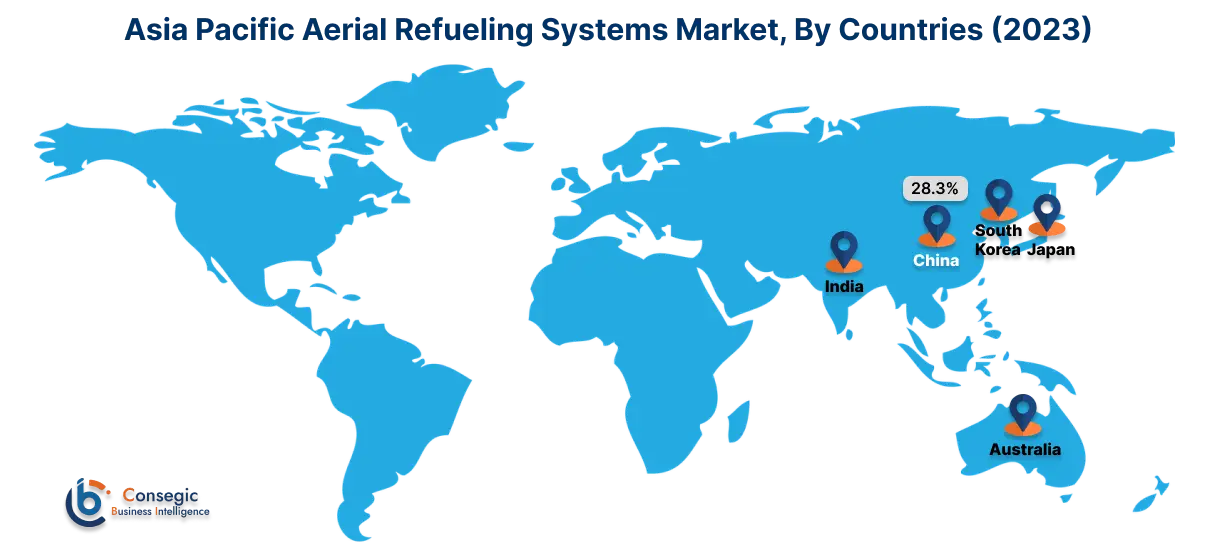
North America is estimated to reach over USD 479.60 Million by 2031 from a value of USD 222.31 Million in 2023 and is projected to grow by USD 240.96 Million in 2024. This region holds a substantial share of the market, primarily due to the United States' extensive military operations and the presence of major defense contractors. The U.S. Air Force's ongoing modernization programs and the deployment of advanced tanker aircraft, such as the Boeing KC-46 Pegasus, are key factors propelling market progress. Additionally, the integration of unmanned aerial vehicles (UAVs) into refueling operations is expected to further enhance market dynamics.
Europe represents a significant portion of the global market, with countries like the United Kingdom, France, and Germany leading in terms of adoption and innovation. The region benefits from strong government support for defense modernization initiatives and a robust industrial base. The focus on enhancing air force capabilities and interoperability among NATO allies further accelerates the adoption of aerial refueling systems.
The Middle East & Africa region shows promising potential in the market, particularly in countries like Saudi Arabia, the United Arab Emirates, and South Africa. Increasing investments in defense infrastructure, a growing focus on enhancing air force capabilities, and strategic military partnerships drive the demand for aerial refueling systems. The expanding defense industry and the adoption of advanced technologies further support market development.
Latin America is an emerging market for aerial refueling systems, with Brazil and Mexico being the primary growth drivers. The rising adoption of advanced military aircraft, improving defense budgets, and increasing focus on enhancing air force capabilities contribute to the market's expansion. Government initiatives aimed at modernizing defense infrastructure and promoting regional security support market progress.
Top Key Players & Market Share Insights:
The Aerial Refueling Systems market is highly competitive with major players providing products and services to the national and international markets. Key players are adopting several strategies in research and development (R&D), product innovation, and end-user launches to hold a strong position in the global Aerial Refueling Systems market. Key players in the Aerial Refueling Systems industry include -
- Boeing Company (USA)
- Airbus SE (Netherlands)
- Lockheed Martin Corporation (USA)
- Northrop Grumman Corporation (USA)
- General Electric Company (USA)
- Safran SA (France)
- Eaton Corporation plc (Ireland)
- Marshall Aerospace and Defence Group (UK)
- Woodward, Inc. (USA)
- Israel Aerospace Industries Ltd. (Israel)
Recent Industry Developments :
Product Enhancements:
- In October 2024, The 9th Air Force introduced the next generation of air refueling capabilities to its region. This advancement is aimed at bolstering mission readiness and enhancing the efficiency of aerial operations. The integration focuses on strengthening partnerships, increasing operational endurance, and providing a critical support system for extended air missions. This development underscores the commitment to maintaining strategic superiority and ensuring sustained operations in the region.
Contracts:
- In September 2024, Legionnaire International secured a $3.19 million AFWERX contract to advance aviation repair solutions. The award supports the development of cutting-edge repair technologies for military and defense applications, aligning with AFWERX's goal to foster innovation within the U.S. Air Force. This initiative enhances operational readiness and sustainability in aviation maintenance.
Aerial Refueling Systems Market Report Insights :
| Report Attributes | Report Details |
| Study Timeline | 2018-2031 |
| Market Size in 2031 | USD 1,556.62 Million |
| CAGR (2024-2031) | 10.3% |
| By Type |
|
| By Component |
|
| By Aircraft Type |
|
| By Application |
|
| By End-User |
|
| By Region |
|
| Key Players |
|
| North America | U.S. Canada Mexico |
| Europe | U.K. Germany France Spain Italy Russia Benelux Rest of Europe |
| APAC | China South Korea Japan India Australia ASEAN Rest of Asia-Pacific |
| Middle East and Africa | GCC Turkey South Africa Rest of MEA |
| LATAM | Brazil Argentina Chile Rest of LATAM |
| Report Coverage |
|
Key Questions Answered in the Report
How big is the Aerial Refueling Systems market? +
Aerial Refueling Systems Market size is estimated to reach over USD 1,556.62 Million by 2031 from a value of USD 709.11 Million in 2023 and is projected to grow by USD 769.71 Million in 2024, growing at a CAGR of 10.3% from 2024 to 2031.
What specific segmentation details are covered in the Aerial Refueling Systems Market report? +
The Aerial Refueling Systems market report includes segmentation details for type (probe and drogue, boom and receptacle, flying boom, autonomous systems), component (refueling pods, refueling probes, fuel tanks, hoses, pumps, valves), aircraft type (fixed-wing, rotary-wing, unmanned aerial vehicles (UAVs)), application (military aviation, commercial aviation, UAV operations), end-user (defense forces, commercial airlines, UAV operators), and region.
Which is the fastest-growing type in the Aerial Refueling Systems market? +
The Autonomous Systems segment is expected to register the fastest CAGR during the forecast period, driven by the growing demand for autonomous aerial refueling platforms, particularly in support of UAVs and advanced military operations.
Who are the major players in the Aerial Refueling Systems market? +
The major players in the Aerial Refueling Systems market include Boeing Company (USA), Airbus SE (Netherlands), Lockheed Martin Corporation (USA), Northrop Grumman Corporation (USA), General Electric Company (USA), Safran SA (France), Eaton Corporation plc (Ireland), Marshall Aerospace and Defence Group (UK), Woodward, Inc. (USA), and Israel Aerospace Industries Ltd. (Israel).
